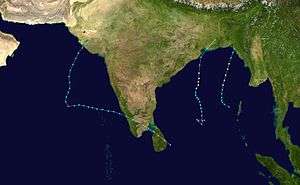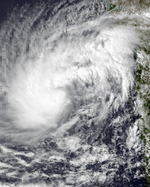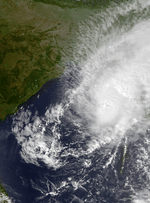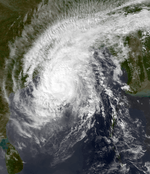1981 North Indian Ocean cyclone season
| 1981 North Indian Ocean cyclone season | |
|---|---|
 Season summary map | |
| Seasonal boundaries | |
| First system formed | October 25, 1981 |
| Last system dissipated | December 10, 1981 |
| Seasonal statistics | |
| Total fatalities | Unknown |
| Total damage | Unknown |
| Related articles | |
The 1981 North Indian Ocean cyclone season was part of the annual cycle of tropical cyclone formation. The season has no official bounds but cyclones tend to form between April and December. These dates conventionally delimit the period of each year when most tropical cyclones form in the northern Indian Ocean. There are two main seas in the North Indian Ocean—the Bay of Bengal to the east of the Indian subcontinent and the Arabian Sea to the west of India. The official Regional Specialized Meteorological Centre in this basin is the India Meteorological Department (IMD), while the Joint Typhoon Warning Center (JTWC) releases unofficial advisories. An average of five tropical cyclones form in the North Indian Ocean every season with peaks in May and November.[1] Cyclones occurring between the meridians 45°E and 100°E are included in the season by the IMD.[2]
Systems
Tropical Storm One (1B)
| Tropical storm (SSHWS) | |
  | |
| Duration | October 28 – November 2 |
|---|---|
| Peak intensity | 110 km/h (70 mph) (1-min) 979 hPa (mbar) |
The monsoon trough spawned a tropical depression just east of Sri Lanka on October 25. The depression tracked northwestward, becoming a tropical storm on the 27th over southern India. Over the Arabian Sea, it turned northeastward where, after reaching a peak of 70 mph winds, it hit western India on the 2nd.
Cyclone Two (2B)
| Category 1 tropical cyclone (SSHWS) | |
  | |
| Duration | November 17 – November 20 |
|---|---|
| Peak intensity | 140 km/h (85 mph) (1-min) 964 hPa (mbar) |
On November 20, Tropical Storm Two, having weakened from a cyclone that developed on the 17th, hit Bangladesh and dissipated soon after.
Cyclone Three (3B)
| Category 1 tropical cyclone (SSHWS) | |
  | |
| Duration | December 5 – December 10 |
|---|---|
| Peak intensity | 140 km/h (85 mph) (1-min) 964 hPa (mbar) |
Cyclone Three, which formed from the monsoon trough in the Bay of Bengal on December 5, reached a peak of 85 mph winds on the 9th. It weakened as it continued northward, and hit near the Indian/Bangladesh border on the 10th as a 60 mph tropical storm. Widespread damage and flooding caused at least 92 fatalities.
See also
- List of North Indian Ocean cyclone seasons
- 1981 Atlantic hurricane season
- 1981 Pacific hurricane season
- 1981 Pacific typhoon season
- Australian cyclone seasons: 1980–81, 1981–82
- South Pacific cyclone seasons: 1980–81, 1981–82
- South-West Indian Ocean cyclone seasons: 1980–81, 1981–82
References
- ↑ "Frequently Asked Questions: What is the annual frequency of Cyclones over the Indian Seas? What is its intra-annual variation?". Indian Meteorological Department. 2012. Archived from the original on May 21, 2015. Retrieved June 8, 2012.
- ↑ "Bulletins Issued by Regional Specialized Meteorological Centre (RSMC) - Tropical Cyclones, New Delhi" (PDF). India Meteorological Department. May 25, 2009. Retrieved July 16, 2012.